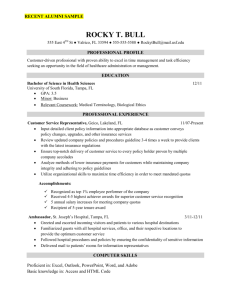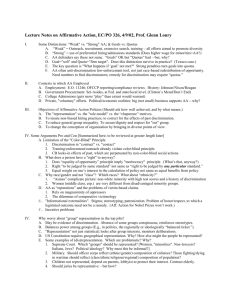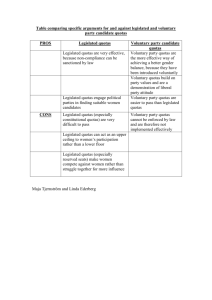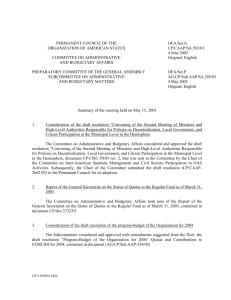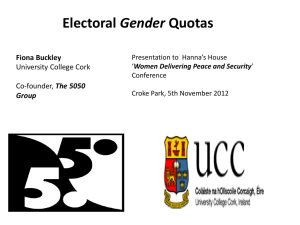LOCAL CONTENT REQUIREMENTS FOR FILM, RADIO, AND
advertisement
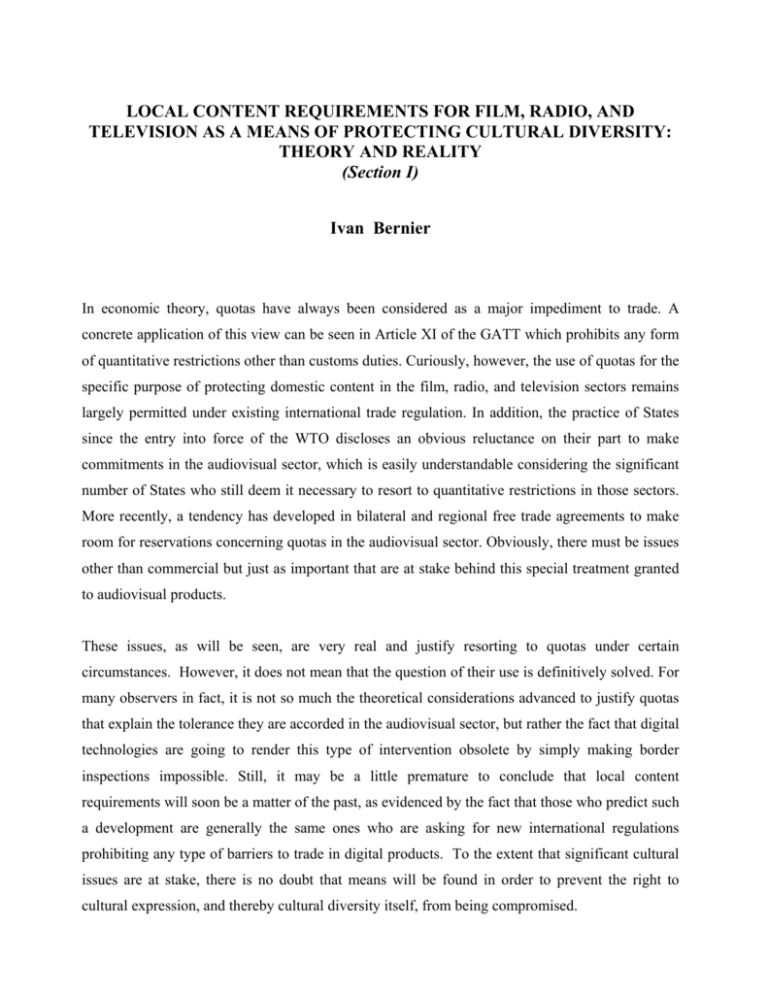
LOCAL CONTENT REQUIREMENTS FOR FILM, RADIO, AND TELEVISION AS A MEANS OF PROTECTING CULTURAL DIVERSITY: THEORY AND REALITY (Section I) Ivan Bernier In economic theory, quotas have always been considered as a major impediment to trade. A concrete application of this view can be seen in Article XI of the GATT which prohibits any form of quantitative restrictions other than customs duties. Curiously, however, the use of quotas for the specific purpose of protecting domestic content in the film, radio, and television sectors remains largely permitted under existing international trade regulation. In addition, the practice of States since the entry into force of the WTO discloses an obvious reluctance on their part to make commitments in the audiovisual sector, which is easily understandable considering the significant number of States who still deem it necessary to resort to quantitative restrictions in those sectors. More recently, a tendency has developed in bilateral and regional free trade agreements to make room for reservations concerning quotas in the audiovisual sector. Obviously, there must be issues other than commercial but just as important that are at stake behind this special treatment granted to audiovisual products. These issues, as will be seen, are very real and justify resorting to quotas under certain circumstances. However, it does not mean that the question of their use is definitively solved. For many observers in fact, it is not so much the theoretical considerations advanced to justify quotas that explain the tolerance they are accorded in the audiovisual sector, but rather the fact that digital technologies are going to render this type of intervention obsolete by simply making border inspections impossible. Still, it may be a little premature to conclude that local content requirements will soon be a matter of the past, as evidenced by the fact that those who predict such a development are generally the same ones who are asking for new international regulations prohibiting any type of barriers to trade in digital products. To the extent that significant cultural issues are at stake, there is no doubt that means will be found in order to prevent the right to cultural expression, and thereby cultural diversity itself, from being compromised. 2 Section I Local Content Requirements in International Trade Regulation Cinema, as some already know, is the object of an explicit exception concerning quotas in Article IV of GATT 1994. How this exception has been interpreted over the years and what it has become in practice will be discussed herein. In the case of radio and television, generally considered part of the service industry, the negotiation formula used regarding market access in the General Agreement on Trade and Services (GATS) authorizes members to make commitments only in the sectors of their choosing and to the extent that they authorize this market access. As long as a member does not renounce its right in negotiations to limit access to radio and television, it is free to maintain quotas in these sectors and even to introduce them if it wishes. How quotas have been used in these two domains until the present time will be examined. A. Local Content Requirements in the Film Sector As an instrument of national policy in the film sector, screen quotas made their appearance at the end of the First World War when several European countries enacted a system of screen quotas to protect their film industry from the sudden and threatening influx of American films, which they perceived as a danger to their cultural expression. The American film industry reacted immediately by demanding that the American government pressure the countries in question so that they end the practice in question. At the end of the Second World War, the American film industry succeeded in partially turning the situation around through agreements negotiated between governments, like the Blum-Byrnes Agreement of 1946 between France and the United States, which accorded more favourable quotas to American films in exchange for aid towards the settlement of France’s war debt, and through arrangements negotiated between the Motion Picture Export Association of America and various governments.1 However, the entry into force of the GATT in 1947, with its Article IV, would temporarily put a stop to the debate. 1 Regarding the development of this dispute between the Wars, see: ANDREW HIGSON et RICHARD MALTBY, ed., “FILM EUROPE” AND “FILM AMERICA” : CINEMA, COMMERCE AND CULTURAL EXCHANGE 1920-1939”, Exeter, University of Exeter Press, 1999, pp. 346-397 ; See also: T. GUBACK, "Non Market Factors in the International Distribution of American Films,". BRUCE A. AUSTIN, dans , ed., Current 3 Article IV of the GATT is an exception to Article III, which prohibits any form of discrimination between domestic and foreign products2. It stipulates that a Member may maintain domestic quotas including the obligation to show, for a specified amount of time, films of domestic origin for a minimum fraction of the overall time of projection actually used; however, it also specifies that screen quotas remain the subject of negotiations aiming to limit their scope or to eliminate them.3 Article IV reproduces in essence Article 19 of the Havana Charter, which, according to Clair Wilcox, was adopted …upon a recognition of the fact that motion picture production is as much entitled to protection against foreign competition as any other industry and that such protection, in this case, cannot be provided effectively by imposing duties on imported rolls of films. The screen quota, therefore, has been accepted as the counterpart of a tariff and every other method of protection (except tariff duties) has been banned.4 However, in the summary analysis of the Havana Charter made public by the Department of State in 1950, a different explanation of Article IV was provided by the American government: films are different than other products, it explains, “more related to domestic cultural policies than to economics and trade because their value lies in the film itself and not in the income it generates.”5 During the negotiations that led to the adoption of the General Agreement on Tariffs and Trade (GATT), a completely different explanation to justify the adoption of what would become Article 2 3 4 5 Research in Films: Audiences, Economics and Law Vol. 1, (Norwood, New Jersey: Ablex Publishing Corporation, 1985), pp. 111, 114-115 ; LAURENT BURIN DES ROZIERS, Du cinéma au multimédia. Une brève histoire de l’exception culturelle, Institut français des relations internationales, Notes de l’IFRI No 5, 1998. Article III : 10 du GATT de 1994 Article IV d) of the GATT of 1994. There are very few indications that negotiations aiming specifically to eliminate screen quotas have taken place within multilateral GATT negotiations. During the Torquay negotiations of 1951, Germany actually included in its list of concessions an agreement to the effect that if it needed to establish screen quotas for foreign films, such quotas would not exceed 27. However, this measure was subsequently withdrawn in 1956 during negotiations on Article XXVII. See GATT, Guide to GATT Law and Practice (1994) 192. WILCOX, CLAIR A., CHARTER FOR WORLD TRADE, New York, The MacMillan Company, 1949, p. 77. (Our translation) Clair Wilcox was the United States representative during the negotiations related to the Havana Charter. See U.N. Doc. EPCT/C.II/W.5, page. 3.4: See JOHN H. J, WORLD TRADE AND THE LAW OF GATT, 293, n 1 (Our translation) 4 4 was advanced by the United Kingdom, Norway and Czechoslovakia, the sponsors of this film exception. In their opinion, important cultural considerations came into question with films, which was not the case with other goods.6 This explanation was also adopted by John H. Jackson who, in his influential 1969 work titled World Trade and the Law of GATT, wrote that the exception concerning films was accepted because it was “more related to domestic cultural policies than to economics and trade”.7 This is also the interpretation that comes out of the account of Article IV prepared by the GATT Secretariat in 1990 during the Uruguay Round negotiations for the Working Group on audiovisual services.8 Recently, the United States advanced a new explanation of Article IV of the GATT. In their December 18, 2000 communication on audiovisual and related services to the WTO Council for Trade in Services, the US stated: GATT Article IV provides a special, and unique, exception for cinematographic films to GATT national treatment rules. In 1947, in recognition of the difficulty that domestic film producers faced in finding adequate screen time to exhibit their films in the immediate post-World War II period, GATT founders authorized continuation of existing screen-time quotas.9 The explanation was rather surprising considering that Article IV concerns as much the establishment of new quotas as the maintenance of existing ones.10 However that may be, it is interesting to note that from the outset and right up to today, European countries have constantly advanced that Article IV was founded on cultural considerations while the United States have advanced essentially economic considerations as its basis. Article IV also raises the important question of whether its language, which targets mainly motion picture films, may be extended to films and programs recorded on video and shown on television. 6 7 8 9 Second Session of the Preparatory Committee of the United Nations Conference on Trade and Development (Geneva 1947), Doc. EPCT/TAC/SR/10 John H. JACKSON, World Trade and the Law of GATT, Indianapolis, Kansas City, New York, The Bobbs Merrill Co. In., 1969, p. 293 (Our translation). See also on the same subject, VAN HARPEN, Robin L., «Mamas, Don’t Let Your Babies Grow Up to Be Cowboys : Reconciling Trade and Cultural Independence» (1995) MINNESOTA JOURNAL OF GLOBAL TRADE, Vol. 4, p. 167 GATT, doc. MTN.GNS/AUD/W/1 October 4, 1990. See WTO, Conseil du commerce des services, Communication des États-Unis, Audiovisual and Related Services, 9, 18 Décembre 2000 : Doc. S/CSS/W/21. 5 This is the source of the problem raised by the United States before the GATT in 1961 in a complaint targeting 20 countries. The United States emphasized that “restrictions against the showing of television programs were technically a violation of the principles of Article III: 4, but that some of the principles of Article IV might apply to them.”11 For its part, Canada expressed the opinion that Article IV covered such situations, even if Article IV did not specifically mention television programming, because such a development could not have been foreseen in 1947.12 Unfortunately, the Working Group established to examine the question was incapable of reaching a consensus on the matter13. Finally in 1991, during consultations with the European Community about restrictions on the showing of non-European films on television within the framework of the “Television without Frontiers” Directive, the United States, while recognizing the Article IV exception, emphasized that the exception applied exclusively to motion picture films.14 Currently, the best that can be said regarding the scope of Article IV is that it still is not entirely clear. Legitimized by Article IV of the 1947 GATT, screen quotas implemented between 1920-1930 survived for many years before being gradually abandoned by most of the countries that had originally adopted them because of pressure put on them for their elimination, but also because of the difficulties encountered in applying this type of measure in practice. This is how Italy ended its own system of screen quotas in 1962 after 11 years of discussions with the Motion Picture Export Association15, followed by Denmark in 1975, the United Kingdom in 198516, and Switzerland in 1993. Other countries however, like Brazil17, Venezuela18, Mexico, and Korea introduced their 10 11 12 13 14 15 16 17 18 Article IV begins: “If any contracting party establishes or maintains internal quantitative regulations relating to exposed cinematograph films, such regulations shall take the form of screen quotas which shall conform to the following requirements” GATT, Analytical Index 1994, p. 192. Some authors, such as Chi Carmody, have also suggested that the restrictive language of Article IV “should not have been interpreted to imply necessarily that the exceptional status given to films could not be extended to other forms of media” because “the language reflected how the situation was understood at that time”: CARMODY, Chi, «When ‘Cultural Identity Was not at Issue’ : Thinking About Canada – Certain Measures concerning Periodicals», (1999) 30 LAW AND POLICY IN INTERNATIONAL BUSINESS, p. 231 at 255. See also BROWN, Michael et PARKER, Leigh, «Trade in Culture: Consumable Product or Cherished Articulation of a Nation’s Soul», (1993) 22 DENVER JOURNAL OF INTERNATIONAL LAW AND POLICY, 155 at 170. GATT, Analytical Index 1994, p. 192. Id. See : http://www.terramedia.co.uk/law/quotas_and_levies.htm (Italy) See : http://www.terramedia.co.uk/law/quotas_and_levies.htm (United Kingdom) In Brazil, a quota on the screen for 28 days local films per year is always in place. See : http://www.ustr.gov/reports/nte/2003/brazil.pdfA A quota concerning the distribution and the presentation in room of national origin films also exists in Venezuela: http://www.ustr.gov/pdf/2000_venezuel.pdf 6 own system of screen quotas after the entry into force of the GATT in 1948. Some countries, like Spain and Italy have also substituted their domestic film screen quotas for a European film screen quota19. Still more recently, in 2002, the largest Russian film production company, Mosfilm, raised the critical situation of the Russian film industry as an argument for the implementation of a system of screen quotas20. In 2003, a similar argument was advanced in order to help the film industry in Slovakia, which was also in a disastrous situation21 . Notwithstanding GATT Article IV, the United States continues to pressure for the abolishment of screen quotas. From 1998-1999, In 1998-1999, a vigorous debate emerged in Korea following the decision of the government to gradually phase out the local screen quota which the U.S. government, in the context of ongoing Seoul-Washington investment negotiations, had described as a protectionist policy22. The debate has persisted since, and has been wrought with conviction to the point where the issue of quotas has practically become for the United States a make or break issue in the negotiation of the agreement. At the beginning of 2004, the problem still had not been solved.23 It is interesting to compare the United States’ position in this matter with the one stated in its December 18, 2000 communication on audiovisual and related services to the WTO Council for Trade in Services, where Article IV was presented as an example of the flexibility of the WTO’s legal system in the cultural sector.24 To conclude on Article IV, it is interesting to note that one of the most common restrictions appearing in the schedules of the WTO members that have undertaken commitments in the audiovisual sector during the Uruguay Round GATS negotiations concerned restrictions on the 19 20 21 22 23 See: http://www.ustr.gov/reports/nte/2003/eu.pdf : The quotas on the screen adopted in 1997 by Spain require that the rooms’ owners reserve one day to the films coming from the European Union for each three days of films coming from the outside of the European Union rather than the one day old ration of European films for each two days of nonEuropean films. In July 2001, after a long debate on the question of knowing if it were necessary to eliminate the quotas on the screen, the Spanish Parliament adopted a new legislation which maintained in place the existing quotas. The new Law provides however that the question of the elimination of the quotas is re-examined in 2006 Pravda, 16 juillet 2002, “Famous Russian film director proposing to introduce quotas for foreign films in Russia : http://english.pravda.ru/culture/2002/07/32596.html. In November 2003 however, President Putin, while acknowledging that the industry was largely in need of aid, objected to the use of screen quotas for this purpose The Slovak Spectator, Volume 9, no 41, octobre/ novembre 2003, « Slovak cinema : gone with the wind” : « http://www.slovakspectator.sk/clanok.asp?cl=14236 See : “Korean Film industry’s plea for screen quota turns emotional”, Korea Herald, June 18, 1999. See for example: Korea Herald, “Film industry leaders protest gov’t bid to ease screen quota regulations”, 29 janvier, 2002. 7 share of screening time allotted to foreign film and television productions.25 The preoccupation that justified the insertion of Article IV seems to still be very much present. B. Local Content Requirements in Radio Since radio is unanimously considered a service, the question of the legality of radio quota with respect to the WTO must be considered within the framework of the GATS. Two provisions in particular, Article XVI, which specifically deals with market access and Article II, which concerns the most-favoured-nation treatment, find application here. Concerning market access, under Article XVI of the GATS, if a Member voluntarily makes commitments concerning market access in a given service sector, the Member, provided it has not included a reservation, limitation, or condition in its list, cannot maintain or adopt limitations in the form of quotas regarding, for instance, the number or total quantity of services produced. Thus, a Member who has made agreements in the radio sector without including limitations of any kind regarding market access will be prohibited from maintaining or adopting radio quotas. Article II provides that Members must grant “to services and service suppliers of any other Member, treatment no less favourable than that it accords to like services and service suppliers of any other country.” This requirement is general in nature and applies to all services, including television and radio services. Thus, when a Member maintains or implements radio quotas, which presumes as we have seen that the member has not made any commitments concerning market access in this sector, it must systematically apply the said quotas to all foreign countries, whether members of the WTO or not. If the Member does not do so, it may be accused of contravening Article II of the WTO. In practice, few Members have made commitments in the audiovisual sector, which includes radio. When GATS entered into force on January 1, 1995, only thirteen member countries - four developed countries (the United States, Japan, Israel, and New Zealand), and 9 developing 24 25 See supra, note 9. WTO, Council on Services, Audiovisual Services, Background Note by the Secretariat, ¶ 29, Doc. S/C/W/40, 15 June 1998 : http://www.wto.org/english/tratop_e/serv_e/w40.doc 8 countries (Hong Kong, India, Kenya, Korea, Malaysia, Mexico, Nicaragua, Singapore, and Thailand) - had made commitments in the audiovisual sector. Since that time, 10 developing countries (Albania, the Central African Republic, the Dominican Republic, El Salvador, Gambia, Jordan, Lesotho, Oman, Panama, and China) and 3 transition economy countries (Georgia, Kyrgyzstan, and Armenia) made commitments in the audiovisual sector when they became members. Among members who made commitments before January 1, 1995, only the United States has made comprehensive commitments in the radio sector (except concerning foreign investment). The situation is different regarding countries that made commitments while negotiating their admission (essentially developing countries and transition economy countries): several of them made comprehensive commitments with no limitations or restrictions in the audiovisual sector, including radio. For these countries, it is hence no longer possible to implement radio quotas in this sector. Although the number of States who currently maintain radio quotas is relatively small, the number has tended to increase rather than decrease over the years. According to a study made public in 2003, Australia was apparently the first to introduce such quotas: The first Australian local content standard was introduced as part of the 1942 Broadcasting Act. This stipulated that not less than of 2.5% of music time be devoted to the work of Australian composers. In 1956 it was raised to 5%. In 1973 the Australian Broadcasting Control Board introduced an auxiliary quota for Australianperformed music; this was initially set at 10% and was increased to 20% in 1976. In 1987 the Tribunal conducted a review of the standard, as a result of which amendments were introduced changing the compliance period from 24 hours a day to between 6am and midnight. The 20% level, along with the 1987 amendments, remained the standard until 1992 when the new Broadcasting Services Act made local content quotas part of a self regulatory code for commercial and community broadcasters. 26 The goal of the self regulatory code currently in place is to facilitate the achievement of one of the objectives of the Broadcasting Services Act 1992, which is to develop and reflect a better perception of the identity, character, and cultural diversity of Australia. The fact that the Australian radio quota is now integrated in a self regulatory code does not change the legal nature of the measure from the perspective of international trade regulation. Since it is linked to 26 Paul Masson, Assessing the impact of Australian music requirements for radio, Paper prepared for the Music Council of Australia, October 2003 : http://www.mca.org.au/masonmusicimpact.htm 9 government measure, namely the Broadcasting Services Act of 1992, it is still considered a government intervention. In 1972, Canada also introduced radio quotas. In their current version, these quotas require that radio stations ensure that a minimum of 35% of popular music songs broadcasted are Canadian and, in the case of francophone radio stations, that a minimum of 55% of popular music songs broadcasted are in French, the two requirements applying both during the week and between 6 a.m. and 6 p.m. Monday through Friday. A little over 20 years later, France was inspired by the Canadian experiment to adopt the Loi du 1er février 1994, which “requires private radio stations to broadcast, beginning January 1, 1996, French-language songs for 40% of their variety music program during peak listening hours, with at least half of the material being from new artists or new productions.”27 In 1997, South Africa adopted in the same vein a regulation titled “The South African Music Local Content Regulation,” which requires at least 20% of music broadcast from 5 a.m. – 11 p.m. to be from South Africa and to be fairly evenly distributed during that time period.28 The purpose of the regulation was to develop, protect, and promote cultural identity on a regional and national level, and to establish a dynamic and creative industry in this domain. These few examples of countries that currently maintain such a system of radio quotas is not exhaustive; these are simply the best documented. In reality, it appears that a larger number of countries than one would think have resorted to radio quotas in order to promote the creation of music within their territories. A comparative study by Richard Letts for the Music Council of Australia in 2003 included three developing countries in this category: Nigeria, with a quota of 80%; the Philippines, with a requirement of at least 4 Philippine compositions per hour; and Uruguay, with a quota of 30%.29 However, nothing indicates that these are the only countries with such practices, and an in-depth study on the topic could show a significantly larger number of States acting likewise. 27 28 29 See http://www.csa.fr/infos/controle/radio_quotas_accueil.php See : Discussion Paper on the Review of Local Content quotas, Afrique du Sud, p. 28ss : http://iba.org.za/local_content.pdf Richard Letts, The Effects of Globalization on Music in Five Contrasting Countries : Australia, Germany, Nigeria, The Philippines and Uruguay, Music Council of Australia, Octobre 2003 : http://www.mca.org.au/pdf/mmresfinal.pdf 10 None of the countries identified as having radio quotas have made specific commitments on market access in the audiovisual sector, so that the legality of their local content requirement cannot be challenged under GATS Article XVI . Nonetheless, there is still the question of whether the radio quotas they have implemented respect their commitment, under Article II, of granting the most-favored-nation treatment. To the extent that the quotas in question aim solely to guarantee a place for local musical expression, the answer seems affirmative: in this case, the quotas are generally applied without discrimination to all foreign States. However, the situation differs when the quotas aim also to protect the use of the local language. When this language is shared with other States, as in the case of French or Spanish for example, the quotas are generally made applicable to any musical production in that language. In this situation, it can be argued that the foreign countries benefiting from those quotas receive preferential treatment compared to other foreign States that do not share the same language. C. Local Content Requirements in Television In 1989, the United States, acting within the framework of the GATT, requested consultations with four countries (Luxemburg, the Netherlands, Spain, and the United Kingdom), regarding the European Convention on Transfrontier Television as well as consultations with the European Community regarding the “Television without Frontiers” Directive, arguing in both cases that the provisions in both texts concerning European television quotas were in conflict with their commitments under the GATT. The European Community granted the consultations but clearly explained that it was doing so without prejudice, considering it was a trade in services and not a GATT issue.30 After a lively exchange of views in the consultations, the matter was later dropped to become part of a wider debate in the context of the Uruguay Round negotiations on services. The entry into force of the GATS in January 1995 added weight to the European Community’s argument concerning the classification of television quotas as a trade in services issue. Indeed, it was clear for most countries that since audiovisual services were part of the nomenclature of services covered by the agreement, television quotas, like radio quotas, fell under Articles XVI and II of GATS and not under Articles III and XI of the GATT. This explains why a country like India, which had made explicit commitments regarding market access in television, felt necessary 11 to exclude its system of television quotas from these commitments; this is also explains why a large number of countries included reservations regarding their obligation under Article II to grant the most-favoured-nation treatment of Article II to cover their audiovisual co-production agreements. In practice, a rather impressive number of States have resorted to quotas in the television sector. In the European Union, Article 4 of the “Television without Frontiers” Directive, which was adopted in 1989, provides that Member States make sure when possible and by appropriate means that radio and television broadcasting organizations reserve a majority portion of their broadcasting time for European works. The directive is generally respected by all Member States. Some of the Member States also use quotas to guarantee a minimum space for their own television production as they are legally justified to do by Article 3 of the Directive, which authorizes the Member States to put in place more detailed or stricter regulations in areas covered by the Directive concerning radio and television broadcasting for organizations that come under their competence. This is the case for instance with France, which requires that television stations maintain a minimum of 60% European works, with 40% of that being original French works, in their programming 31; it is also the case with Spain, which reserves 51% of television broadcasting time of European production in Spanish or one of the other minority languages used in Spain32. Beyond Europe, there are local content quotas for television in such diverse countries as Canada, Australia, South Africa, Argentina, Brazil, Chile, Venezuela, Costa Rica, Korea, and China33. More often than not, these requirements are immediately applicable, but in some cases, like in Argentina and Chile, they only become applicable when a decree is adopted stating that the local content quota has not been met. The effectiveness of those different quota systems is dependent in practice on the actual importance given to the fulfilment of the requirements in question, certain States being from that point of view more indulgent than others. In practice, every country that currently maintains local content quotas for television has abstained to date from making commitments regarding market access for this sector within the framework of 30 31 32 33 GATT, doc. DS4/4, 8 november 1989 See : http://www.culture.gouv.fr/culture/dglf/rapport/1999/quotas-diffusion.html See : http://www.pc.gov.au/inquiry/broadcst/finalreport/appendixf.pdf This list serves as an example and is not in any way exhaustive. 12 the GATS, thus preserving its freedom of action at this level. However, the situation is different in bilateral or regional free trade agreements that have been concluded in recent years. Even though some of these agreements, like the one between Canada and Chile34 and the one between the European Union and Chile35, completely exclude the audiovisual sector from their scope, this is not the case with free trade agreements concluded by the United States with Chile36, Singapore37, Australia38, and Costa-Rica39, which are in theory applicable to this sector but include reservations for local content quotas, at least concerning conventional television. The second section will consider the significance of such concessions in light of the United States refusal to allow any form of trade obstacle in electronic services. But before, it is necessary to consider more closely why local content requirements remain in certain an important tool to preserve distinct cultural expressions in the film, radio, and television sectors. 34 35 36 37 38 39 See : http://www.dfait-maeci.gc.ca/tna-nac/cda-chile/menu-fr.asp See :http://europa.eu.int/comm/trade/issues/bilateral/countries/chile/docs/euchlagr_i_fr.pdf See : http://www.ustr.gov/new/fta/Chile/text/index.htm See: http://www.ustr.gov/new/fta/Singapore/consolidated_texts.htm See : http://www.ustr.gov/releases/2004/02/2004-02-08-transcript-australia.pdf See : http://www.ustr.gov/new/fta/Cafta/text/index.htm
